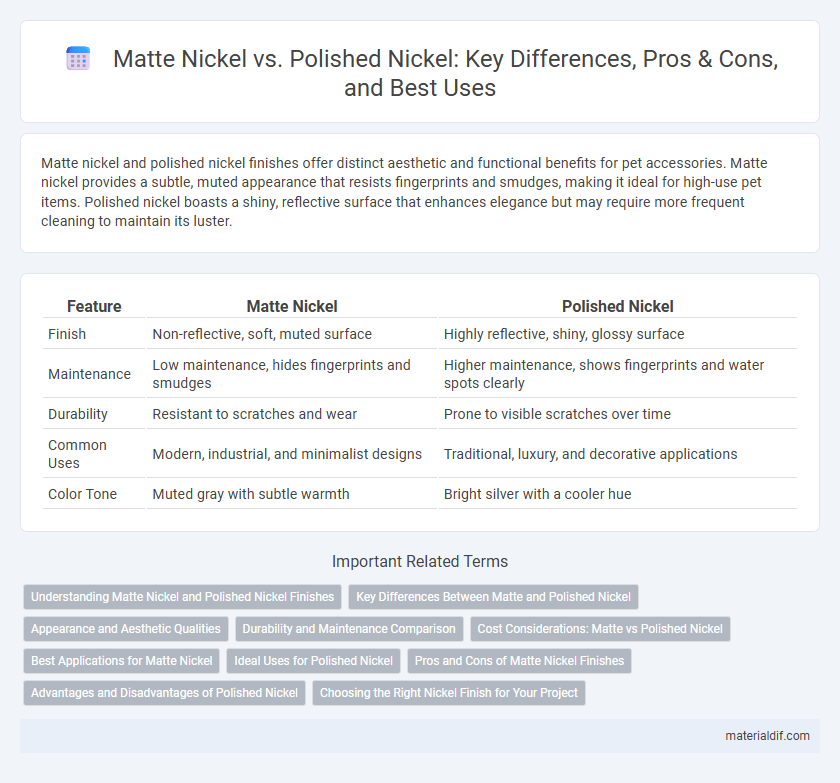Matte nickel and polished nickel finishes offer distinct aesthetic and functional benefits for pet accessories. Matte nickel provides a subtle, muted appearance that resists fingerprints and smudges, making it ideal for high-use pet items. Polished nickel boasts a shiny, reflective surface that enhances elegance but may require more frequent cleaning to maintain its luster.
Table of Comparison
| Feature | Matte Nickel | Polished Nickel |
|---|---|---|
| Finish | Non-reflective, soft, muted surface | Highly reflective, shiny, glossy surface |
| Maintenance | Low maintenance, hides fingerprints and smudges | Higher maintenance, shows fingerprints and water spots clearly |
| Durability | Resistant to scratches and wear | Prone to visible scratches over time |
| Common Uses | Modern, industrial, and minimalist designs | Traditional, luxury, and decorative applications |
| Color Tone | Muted gray with subtle warmth | Bright silver with a cooler hue |
Understanding Matte Nickel and Polished Nickel Finishes
Matte nickel finishes offer a soft, non-reflective surface that resists fingerprints and smudges, making them ideal for high-traffic areas and modern interior designs. Polished nickel provides a bright, reflective shine that enhances traditional and contemporary aesthetics, often requiring more maintenance to preserve its glossy appearance. Both finishes use nickel plating but differ in texture and sheen, influencing durability and visual impact.
Key Differences Between Matte and Polished Nickel
Matte nickel features a dull, non-reflective surface that resists fingerprints and smudges, making it ideal for high-traffic areas. Polished nickel offers a shiny, mirror-like finish that enhances brightness and adds a sophisticated, elegant look to fixtures. The key differences lie in their appearance, maintenance needs, and resistance to wear, with matte nickel providing a more subtle aesthetic and polished nickel delivering a glossy, vibrant appeal.
Appearance and Aesthetic Qualities
Matte nickel features a soft, muted finish with a subtle sheen that resists fingerprints and smudges, making it ideal for understated, modern designs. Polished nickel offers a highly reflective, glossy surface that enhances visual brightness and luxury through its mirror-like sheen. The choice between them depends on desired aesthetic impact, with matte nickel providing a contemporary, low-gloss appeal and polished nickel delivering classic elegance and shine.
Durability and Maintenance Comparison
Matte nickel offers superior resistance to scratches and fingerprints compared to polished nickel, making it more durable in high-traffic areas. Polished nickel requires regular cleaning to maintain its glossy finish, as it shows smudges and tarnish more easily. Both finishes benefit from protective coatings, but matte nickel generally demands less maintenance over time.
Cost Considerations: Matte vs Polished Nickel
Matte nickel typically costs less than polished nickel due to its less intensive finishing process and lower demand in luxury markets. Polished nickel requires additional labor and materials for buffing and clear-coating, driving up its price. Budget-conscious projects often favor matte finishes for cost-effectiveness without sacrificing corrosion resistance.
Best Applications for Matte Nickel
Matte nickel features a non-reflective, brushed finish that resists fingerprints and scratches, making it ideal for high-traffic areas such as kitchen fixtures, bathroom hardware, and door handles. This finish complements contemporary and industrial design styles, providing a subtle, sophisticated look that hides wear while maintaining durability. Matte nickel's corrosion resistance and low maintenance requirements enhance its suitability for both residential and commercial applications where long-lasting performance is essential.
Ideal Uses for Polished Nickel
Polished nickel offers a reflective, shiny finish that enhances modern and contemporary interior designs, making it ideal for fixtures like faucets, lighting, and hardware where a sleek appearance is desired. Its corrosion-resistant properties suit humid environments such as bathrooms and kitchens, providing both durability and aesthetic appeal. The smooth, high-gloss surface of polished nickel resists tarnishing, ensuring long-lasting visual impact in high-traffic areas.
Pros and Cons of Matte Nickel Finishes
Matte nickel finishes offer a subtle, non-reflective surface that resists fingerprints and water spots, making them ideal for high-use areas like kitchens and bathrooms. Their muted appearance complements modern and industrial design styles but can show scratches more easily compared to polished nickel. Matte nickel is also durable and low-maintenance, though it may lack the bright, shiny aesthetic that polished nickel provides.
Advantages and Disadvantages of Polished Nickel
Polished nickel offers a highly reflective, mirror-like finish that enhances the aesthetic appeal of fixtures and hardware by providing a bright, modern look. Its smooth surface resists tarnishing better than matte nickel, making it more durable and easier to clean, though fingerprints and water spots are more visible. However, polished nickel can show scratches more readily, requiring regular maintenance to preserve its shine, unlike matte nickel, which conceals imperfections more effectively.
Choosing the Right Nickel Finish for Your Project
Matte nickel offers a subtle, muted sheen ideal for contemporary or industrial designs seeking a low-glare, understated look, while polished nickel features a bright, reflective surface that enhances traditional or elegant styles with its high shine. Consider environmental factors and maintenance needs; matte finishes hide fingerprints and water spots better, making them practical for high-traffic areas, whereas polished nickel requires regular cleaning but provides a luxe appearance. Selecting the right nickel finish depends on balancing aesthetic preferences, durability, and the specific functional requirements of your project.
Matte Nickel vs Polished Nickel Infographic

 materialdif.com
materialdif.com